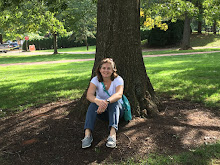We decided to return to mixing colors and exploring color relationships; interests that emerged in the group while painting the chairs.

We began with plumb lines (a carpentry tool) to make chalk lines to form a design for a group mural painting.

After creating a design with lines, the children mixed paint in individual jars. They recorded their color "recipes" and named the colors they created.

Colors from the group palette. The cards under the jars record the names of the colors and the recipe (written in numbers of squirts of red, yellow, blue, and white). The children enjoyed helping each other figure out color recipes and names for colors.

The worked in groups of three to fill in the shapes created by their lines.

As they filled in more spaces, new colors were needed and created. The conversation returned to ideas about how colors relate to each other and what makes a color stand out or "pop."

The more spaces they filled, the more consideration was needed about what color would go in a space as there were more relationships to consider with a number of colors surrounding the free space. It became like a puzzle of creating or finding the right color for a free space based on the colors around it.

As with many group projects it required some planning as you go, as well as flexibility on the part of the participants. The group conversation became more involved as the color relationships became more complex as they filled the spaces in the mural.

 We began with plumb lines (a carpentry tool) to make chalk lines to form a design for a group mural painting.
We began with plumb lines (a carpentry tool) to make chalk lines to form a design for a group mural painting. After creating a design with lines, the children mixed paint in individual jars. They recorded their color "recipes" and named the colors they created.
After creating a design with lines, the children mixed paint in individual jars. They recorded their color "recipes" and named the colors they created. Colors from the group palette. The cards under the jars record the names of the colors and the recipe (written in numbers of squirts of red, yellow, blue, and white). The children enjoyed helping each other figure out color recipes and names for colors.
Colors from the group palette. The cards under the jars record the names of the colors and the recipe (written in numbers of squirts of red, yellow, blue, and white). The children enjoyed helping each other figure out color recipes and names for colors. The worked in groups of three to fill in the shapes created by their lines.
The worked in groups of three to fill in the shapes created by their lines. As they filled in more spaces, new colors were needed and created. The conversation returned to ideas about how colors relate to each other and what makes a color stand out or "pop."
As they filled in more spaces, new colors were needed and created. The conversation returned to ideas about how colors relate to each other and what makes a color stand out or "pop." The more spaces they filled, the more consideration was needed about what color would go in a space as there were more relationships to consider with a number of colors surrounding the free space. It became like a puzzle of creating or finding the right color for a free space based on the colors around it.
The more spaces they filled, the more consideration was needed about what color would go in a space as there were more relationships to consider with a number of colors surrounding the free space. It became like a puzzle of creating or finding the right color for a free space based on the colors around it. As with many group projects it required some planning as you go, as well as flexibility on the part of the participants. The group conversation became more involved as the color relationships became more complex as they filled the spaces in the mural.
As with many group projects it required some planning as you go, as well as flexibility on the part of the participants. The group conversation became more involved as the color relationships became more complex as they filled the spaces in the mural.





 Here we were painting on a black board and also offered sticks to draw lines back into the wet paint. This child discovered the opposite end of the brush also worked for drawing lines in the paint. He would paint and then flip the brush and draw lines and then return to cover over them moving the paint around with the brush again, each time stating paint, draw, paint and looking around to see that we saw he was changing his activity even though he had the same tool.
Here we were painting on a black board and also offered sticks to draw lines back into the wet paint. This child discovered the opposite end of the brush also worked for drawing lines in the paint. He would paint and then flip the brush and draw lines and then return to cover over them moving the paint around with the brush again, each time stating paint, draw, paint and looking around to see that we saw he was changing his activity even though he had the same tool.
 Selecting jewel-like glass pieces to begin.
Selecting jewel-like glass pieces to begin.

 Planning patterns to frame and fill in the space around the mirror.
Planning patterns to frame and fill in the space around the mirror.
 Exploring symmetry, shape and grouping of warm and cool colors.
Exploring symmetry, shape and grouping of warm and cool colors.



 A new sheet pressed from a circle mold.
A new sheet pressed from a circle mold.
 Pouring pulp onto a group piece.
Pouring pulp onto a group piece.
